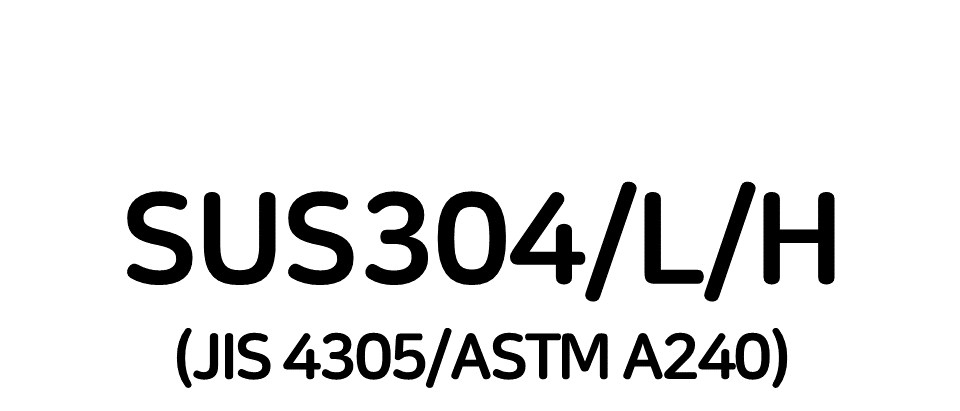-
About
-
Our Brand
-
Products
-
Community
Community
Blog
Blog
US304: Standards, Chemical Composition, Characteristics, Mechanical & …
- Writer
- STEELTOPIA
- Date
- 25-02-12
SUS304: Standards, Chemical Composition, Characteristics, Mechanical & Physical Properties, and Applications
SUS304/304L/304H Characteristics and Applications
▶ SUS304
SUS304 is the most representative austenitic stainless steel and is also known as 18-8 stainless steel. This name originates from its primary alloying elements, chromium (approximately 18%) and nickel (approximately 8%). The combination of these elements provides SUS304 with excellent corrosion resistance and easy workability, making it widely used across various industries. The chromium and nickel composition ensures the high durability and chemical stability of SUS304, allowing it to perform exceptionally well in different environments.
As the most commonly used grade of austenitic stainless steel, SUS304 offers excellent corrosion resistance and mechanical properties, making it a preferred choice in various industries. However, depending on the specific usage and environment, modified grades with slightly different properties are available. The most notable among them are SUS304L and SUS304H.
▶ SUS304L
SUS304L is a low-carbon variant of SUS304, where the 'L' stands for "Low Carbon." The carbon content is kept at 0.03% or lower, which reduces carbide precipitation during welding. As a result, SUS304L maintains excellent corrosion resistance even after welding, making it suitable for applications requiring high resistance to intergranular corrosion. It is particularly used in industries requiring frequent welding, such as chemical processing equipment and piping systems. The reduced carbon content enhances resistance to intergranular corrosion, ensuring stable performance even in high-temperature environments.
▶ SUS304H
SUS304H is another variant of SUS304, where the 'H' stands for "High Carbon." The carbon content is relatively higher, ranging from 0.04% to 0.10%, which increases its high-temperature strength. SUS304H exhibits superior tensile and yield strength at elevated temperatures, making it suitable for high-temperature environments such as pressure vessels and heat exchangers. Due to its excellent durability under prolonged high-temperature exposure, SUS304H is widely used in industrial equipment and the energy sector.
Equivalent Standards by Region
The designation SUS304 originates from the Japanese JIS standard. However, it has different names under various international standards:
- Korean KS standard: STS304
- UNS designation: S30400
- British BS standard: 304S31
- European EN standard: 1.4301
- German DIN standard: X5CrNi 18-10
- Chinese GB standard: 06Cr19Ni10
In South Korea, the Japanese JIS designation (SUS304) is commonly used in industrial and commercial applications.
Chemical Composition
% | 304 | 304L | 304H |
C | ≤ 0.08% | ≤ 0.03% | 0.04-0.10% |
Cr | 18.0-20.0% | 18.0-20.0% | 8.0-10.5% |
Ni | 8.0-10.5% | 8.0-12.0% | 8.0-10.5% |
Mn | ≤ 2.0% | ≤ 2.0% | ≤ 2.0% |
Si | ≤ 1.0% | ≤ 1.0% | ≤ 1.0% |
P | ≤ 0.045% | ≤ 0.045% | ≤ 0.045% |
S | ≤ 0.03% | ≤ 0.03% | ≤ 0.03% |
Mechanical Properties
Mechinical Properties | 304 | 304L | 304H |
Tensile Strength (MPa) | ≥ 520 | ≥ 485 | ≥ 520 |
Yield Strength (MPa) | ≥ 205 | ≥ 175 | ≥ 205 |
Elongation (%) | ≥ 40 | ≥ 40 | ≥ 40 |
Hardness (HRB) | ≤ 90 | ≤ 90 | ≤ 95 |
Physical Properties of SUS304
SUS304 has a thermal conductivity of approximately 16.2 W/(m·K), which is relatively low—a typical characteristic of stainless steel. Its density is 8.0 g/cm³, making it relatively heavy, and its coefficient of thermal expansion is about 17.2 µm/m·°C at 20°C. These physical properties allow SUS304 to maintain structural stability in both high and low-temperature environments. Additionally, its electrical resistivity is 0.072 Ω·mm²/m, providing a relatively high level of electrical insulation.
Corrosion Resistance
304 stainless steel exhibits excellent corrosion resistance in various environments and maintains its properties even when exposed to corrosive media. However, in chloride-containing environments, it may be susceptible to pitting corrosion and crevice corrosion. Additionally, at temperatures above 60°C, there is a risk of stress corrosion cracking (SCC).
Heat Resistance
Forms of SUS304
▶ Pipe
▶ Tube
▶ Round Bar
▶ Sheet
▶ Plate
▶ Coil
▶ Fittings
Uses of SUS304
SUS304 is widely used in various industries. Its value is particularly evident in environments requiring corrosion resistance. It is applied in numerous areas, from household products such as pots, kitchen appliances, sinks, and cooking tools, to fittings like springs, screws, nuts, and bolts, and industrial equipment like chemical equipment, storage tanks, and pipelines. In the construction field, it is used for exterior finishes, railings, and door handles, and in the automotive industry, it is applied to components such as exhaust systems. In the food industry, it is mainly used for food processing equipment due to its hygienic properties.
SUS304 is the most widely used grade among austenitic stainless steels, and its unique corrosion resistance, mechanical properties, and physical characteristics make it suitable for various applications. Its excellent corrosion resistance, machinability, and weldability allow it to be manufactured into various forms, making it an essential material in many industries. Due to these properties, SUS304 will continue to play a crucial role in various fields.
Steeltopia handles various products made of stainless steel 304, such as schedule pipes, non-standard pipes, and round bars. If you have any questions regarding these products, please feel free to contact us. Thank you!
I hope this helps! If you have any further questions or need additional assistance, feel free to ask.



 HOME
HOME